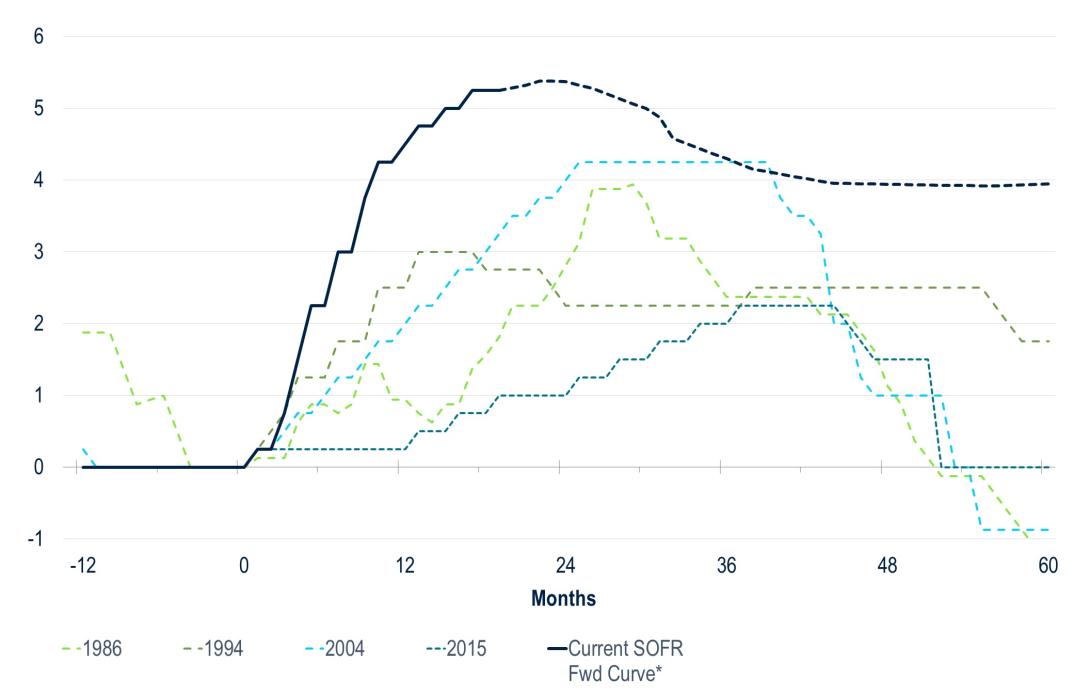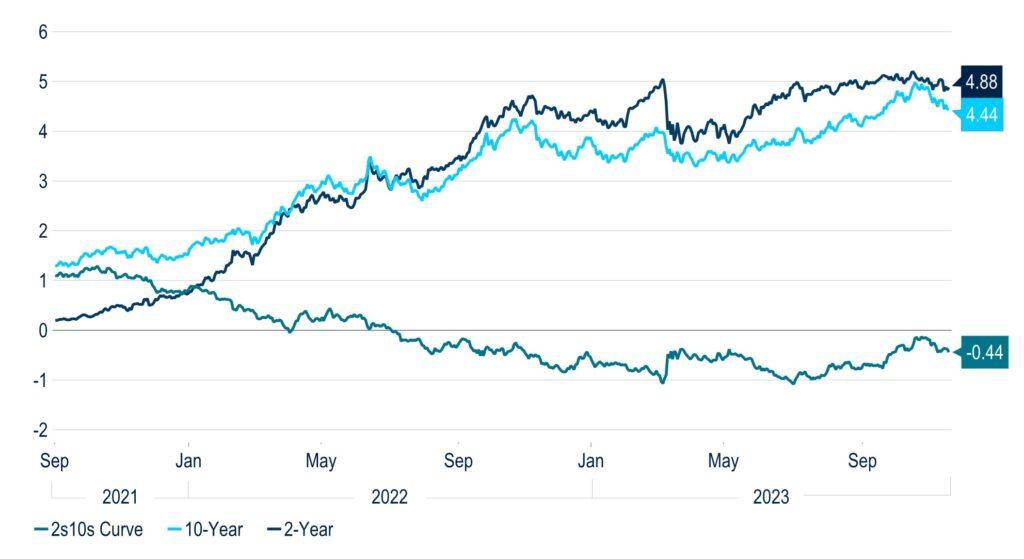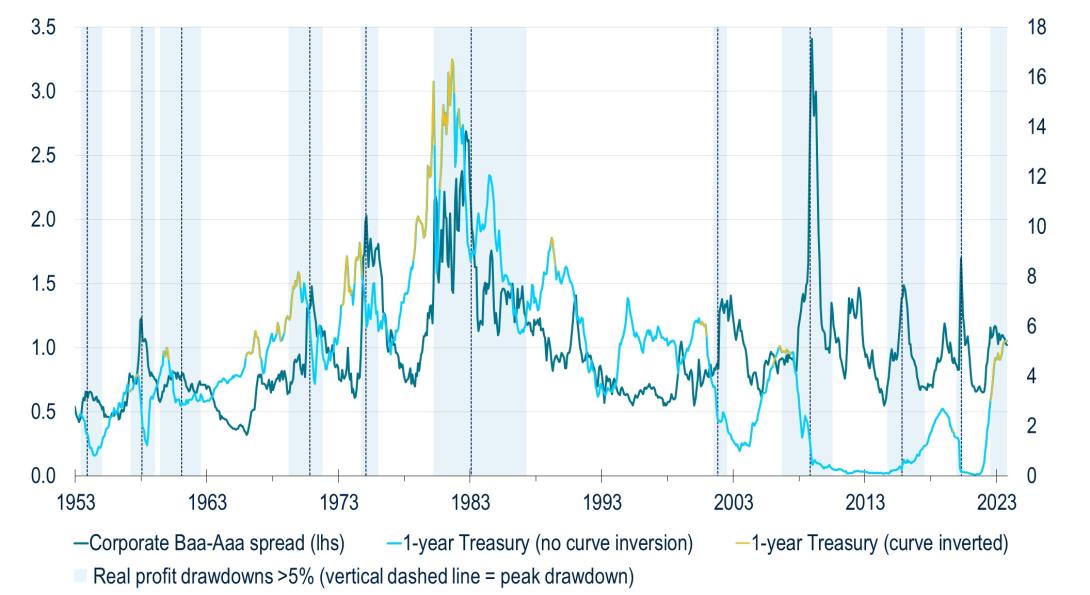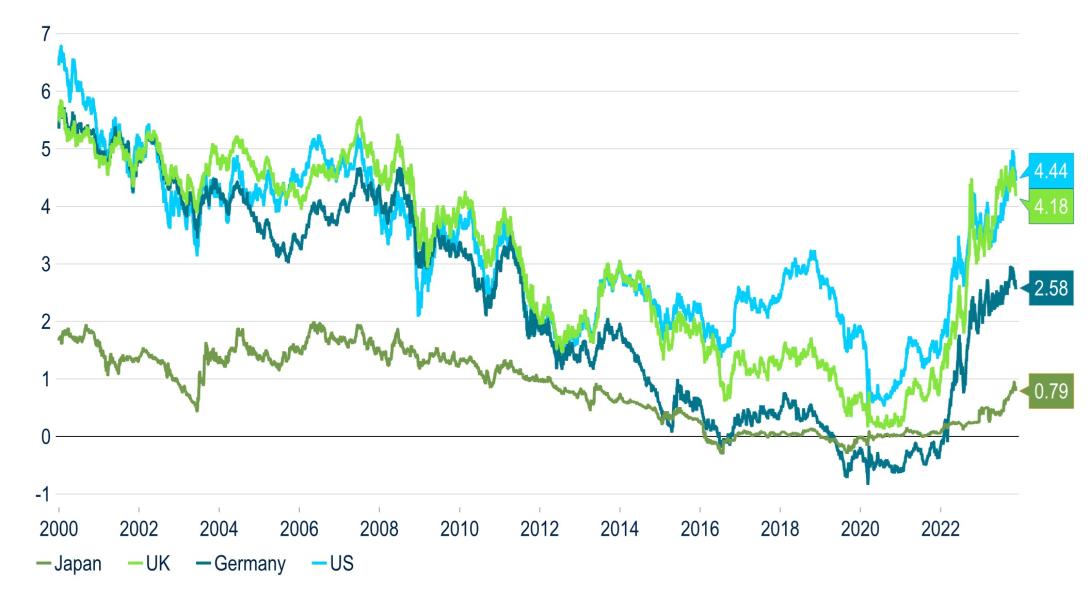Tracking the Transition from Tighter Policy to Corporate Spreads
One of the most impressive features of the current Fed tightening cycle has been the resilience of the U.S. economy and the associated outperformance of U.S. assets. While we cannot rule out a cyclical downturn in the months to come, we’ve found several factors in the current cycle that have reduced the U.S. economy’s interest-rate sensitivity. This feature has potentially underpinned the resiliency of U.S. corporate profits in the face of higher interest rates and pressure on profit margins. Indeed, our corporate profits outlook is fairly benign in most of our macro scenarios, including our base case of slow growth and elevated, but falling, inflation.
In the concluding piece of our interest-rate sensitivity package, we explore the historical transmission from tighter monetary policy to corporate bond spreads and discuss the respective investment implications under our “weakflation” scenario.
Extrapolating Tighter Policy to Corporate Profits and Asset Prices
The economic and market outlook remains riddled by a highly idiosyncratic cyclical outlook, as well as secular forces that are reshaping some important long-term drivers of growth and inflation. Indeed, the Fed’s latest policy tightening has been more aggressive both in size and speed than in previous cycles (Figure 1).
Figure 1: The Fed’s historically aggressive tightening cycle (change since t0 in percentage points).

Source: Bloomberg and PGIM Fixed Income. *1-month tenor
Ultimately, the key determinant for central banks is whether that tightening is restrictive enough to moderate the pace of inflation. While policy’s effect on inflation can be difficult to quantify, the shape of the yield curve is not a bad way of gauging the level of monetary tightening that is needed to cool the economy and lower inflation. Figure 2 shows that in the U.S., about 16 months have passed since the 2/10s curve inverted. What does that length of inversion mean for valuations on fixed income assets, such as credit spreads on corporate bonds?
Figure 2: An inverted U.S. yield curve as a proxy for restrictive Fed policy (%).

Source: PGIM Fixed Income and Macrobond.
It is well understood that monetary policy progresses through the economy with long and variable lags. Further, during tightening cycles, prices on risk assets can quickly reflect anticipation for weaker macroeconomic fundamentals. Figure 3 demonstrates how this sequencing unfolded during previous Fed tightening cycles. As the Fed tightens policy, the yield curve inverts (yellow sections) and usually foreshadows corporate profit drawdowns (light blue columns). Corporate spreads typically widen as those profit drawdowns become deeper. It takes time for spreads to peak, but they usually do so when profit recessions (drawdowns) hit a trough.
Figure 3: Overtightening affects corporate profits and spreads with a significant lag (%).

Source: PGIM Fixed Income and Bloomberg.
Figure 4 explores the timing from the first point of curve inversion to the peak in corporate credit spreads. We find that these lags average 26 months, but they vary materially from cycle to cycle. In fact, they can be as long as several years and tend to be longer in high inflation episodes (like the 1970-80s). We are about 16 months into curve inversion in the U.S., thus we are closer to the zone historically associated with wider spreads. However, we are careful about being too precise considering the large variability around this mean.
Figure 4: After the curve inverts, spreads peak an average of about two years later (months).
 Source: PGIM Fixed Income and NBER.
Source: PGIM Fixed Income and NBER.
In fact, there might be other reasons behind the cyclical resilience of the U.S. economy beyond the usual long and variable lags of monetary policy. As discussed in our accompanying white paper a staggered adjustment process in various interest-sensitive sectors may be acting as a cushion that lowers the economy’s sensitivity to interest rates going forward and otherwise blunts the total impact of tighter monetary policy.
Investment Implications—Grasping Yield Opportunities
The prospect of higher-for-longer core bond yields restored the attractiveness of fixed income as an asset class, but with a caveat. Despite periods of sizable rallies and selloffs—resulting in wide trading ranges and enhanced tactical opportunities—we don’t think its strategic attractiveness is due to possible capital appreciation. Rather, the new, elevated level of yields and the respective carry potential present a compelling opportunity set. Furthermore, this return profile dovetails with our preference for high-quality spread products and to capitalize on wide dispersions within the respective sectors.
In the government bonds space, 10-year U.S. and German government bond yields have reset to higher levels. In comparison to the prior regime of historically low inflation and interest rates, the current paradigm may last into the foreseeable future (Figure 5). Pockets of stubborn inflation, higher neutral interest rates, and rising Treasury issuance amid the Fed’s quantitative tightening remain upside risks to yields. Disinflation and recessions are the main downside risks.
Figure 5: U.S. and German yields look set to remain elevated into the foreseeable future (%).

Source: Macrobond and Bloomberg.
An environment of weakening global growth and elevated, but falling, inflation (i.e., our macroeconomic base case of “weakflation”) can be a constructive one for spread products. Indeed, U.S. IG and HY spreads can remain range bound around their historical averages in a “weakflation” environment (Figure 6) and, in doing so, maintain what has become an increasingly attractive carry opportunity. We have a preference for IG over HY as our base case involves “higher for longer” rates that could hurt levered capital structures. We have more long-term confidence in U.S. assets given the better growth prospects versus those in other regions. European corporate bond spreads offer higher spreads, largely because they already discount weaker prospects for the economy and the corporate sector.
Figure 6: “Weakflation” supports U.S. spreads, but lingering risks warrant a preference for high-quality spread products (bps).

Source: ICE BofAML, PGIM Fixed Income and ICE Data Indices, LLC, used with permission. An investment cannot be made directly in an index.
Concluding Thoughts
While acknowledging that we’ve entered a new paradigm is a necessary investing step, meeting clients’ various objectives also requires identifying the contours of the emerging regime. Indeed, our research series establishes a relationship between easing supply chain constraints and a staggered economic adjustment to rising interest rates. This sequential reaction is a key aspect that may mitigate the economy’s sensitivity to interest rates going forward. That said, each cycle presents a different lag in the transmission between policy adjustments and the real economy, and our research shows that the full effects of the current cycle’s tightening campaign have yet to be felt. As that transmission process continues, it points to a backdrop consistent with our “weakflation” base case.
Weakflation conditions would seemingly pose a tangible threat to corporate profit margins, as well as corporate credit spreads. However, our modeling of profit margins under our macro scenarios reveals that most of the compression has already occurred. Taking it a step further, under our base case, we consequently expect corporate profits to drift sideways from here. When we shift to a probability-weighted forecast based on our scenarios—including the recession scenario’s outsized effect—profits continue to appear resilient amid our projection that they flatline into 2024.
Although the prolonged inversion of the U.S. Treasury curve is consistent with a recession scenario, the factors identified in our research likely mitigated the forces that would have otherwise pulled the economy into a recession by now. The relative buoyancy of the economy and corporate profits points to fixed income opportunities, but perhaps in a different manner than prior periods of positive returns. While there may be periods of capital appreciation as observed in November 2023, we believe that carry opportunities from higher yields will generate the bulk of fixed income returns in the future. In that context, we believe we can meet various investment objectives without taking undue credit risk in overly levered capital structures and with an emphasis on U.S. assets amidst the country’s relative economic stability.
Read More From PGIM Fixed Income
The comments, opinions, and estimates contained herein are based on and/or derived from publicly available information from sources that PGIM Fixed Income believes to be reliable. We do not guarantee the accuracy of such sources or information. This outlook, whch is for informational purposes only, sets forth our views as of this date. The underlying assumptions and our views are subject to change. Past performance is not a guarantee or a reliable indicator of future results.
Source(s) of data (unless otherwise noted): PGIM Fixed Income, as of December 7, 2023.
For Professional Investors only. Past performance is not a guarantee or a reliable indicator of future results and an investment could lose value. All investments involve risk, including the possible loss of capital.
For Professional Investors only. Past performance is not a guarantee or a reliable indicator of future results and an investment could lose value. All investments involve risk, including the possible loss of capital.
PGIM Fixed Income operates primarily through PGIM, Inc., a registered investment adviser under the U.S. Investment Advisers Act of 1940, as amended, and a Prudential Financial, Inc. (“PFI”) company. Registration as a registered investment adviser does not imply a certain level or skill or training. PGIM Fixed Income is headquartered in Newark, New Jersey and also includes the following businesses globally: (i) the public fixed income unit within PGIM Limited, located in London; (ii) PGIM Netherlands B.V., located in Amsterdam; (iii) PGIM Japan Co., Ltd. (“PGIM Japan”), located in Tokyo; (iv) the public fixed income unit within PGIM (Hong Kong) Ltd. located in Hong Kong; and (v) the public fixed income unit within PGIM (Singapore) Pte. Ltd., located in Singapore (“PGIM Singapore”). PFI of the United States is not affiliated in any manner with Prudential plc, incorporated in the United Kingdom or with Prudential Assurance Company, a subsidiary of M&G plc, incorporated in the United Kingdom. Prudential, PGIM, their respective logos, and the Rock symbol are service marks of PFI and its related entities, registered in many jurisdictions worldwide.
These materials are for informational or educational purposes only. The information is not intended as investment advice and is not a recommendation about managing or investing assets. In providing these materials, PGIM is not acting as your fiduciary. PGIM Fixed Income as a general matter provides services to qualified institutions, financial intermediaries and institutional investors. Investors seeking information regarding their particular investment needs should contact their own financial professional.
These materials represent the views and opinions of the author(s) regarding the economic conditions, asset classes, securities, issuers or financial instruments referenced herein. Distribution of this information to any person other than the person to whom it was originally delivered and to such person’s advisers is unauthorized, and any reproduction of these materials, in whole or in part, or the divulgence of any of the contents hereof, without prior consent of PGIM Fixed Income is prohibited. Certain information contained herein has been obtained from sources that PGIM Fixed Income believes to be reliable as of the date presented; however, PGIM Fixed Income cannot guarantee the accuracy of such information, assure its completeness, or warrant such information will not be changed. The information contained herein is current as of the date of issuance (or such earlier date as referenced herein) and is subject to change without notice. PGIM Fixed Income has no obligation to update any or all of such information; nor do we make any express or implied warranties or representations as to the completeness or accuracy.
Any forecasts, estimates and certain information contained herein are based upon proprietary research and should not be interpreted as investment advice, as an offer or solicitation, nor as the purchase or sale of any financial instrument. Forecasts and estimates have certain inherent limitations, and unlike an actual performance record, do not reflect actual trading, liquidity constraints, fee. These materials are not intended as an offer or solicitation with respect to the purchase or sale of any security or other financial instrument or any investment management services and should not be used as the basis for any investment decision. PGIM Fixed Income and its affiliates may make investment decisions that are inconsistent with the recommendations or views expressed herein, including for proprietary accounts of PGIM Fixed Income or its affiliates.
Investing in the bond market is subject to risks, including market, interest rate, issuer, credit, inflation risk, and liquidity risk. The value of most bonds and bond strategies are impacted by changes in interest rates. Bonds and bond strategies with longer durations tend to be more sensitive and volatile than those with shorter durations; bond prices generally fall as interest rates rise, and low interest rate environments increase this risk. Reductions in bond counterparty capacity may contribute to decreased market liquidity and increased price volatility. Bond investments may be worth more or less than the original cost when redeemed. Mortgage- and asset-backed securities may be sensitive to changes in interest rates, subject to early repayment risk, and while generally supported by a government, government agency or private guarantor, there is no assurance that the guarantor will meet its obligations. High yield, lower-rated securities involve greater risk than higher-rated securities; portfolios that invest in them may be subject to greater levels of credit and liquidity risk than portfolios that do not. Investing in foreign-denominated and/or -domiciled securities may involve heightened risk due to currency fluctuations, and economic and political risks, which may be enhanced in emerging markets. Currency rates may fluctuate significantly over short periods of time and may reduce the returns of a portfolio. Commodities contain heightened risk, including market, political, regulatory and natural conditions, and may not be suitable for all investors. Diversification does not ensure against loss.
In the United Kingdom, information is issued by PGIM Limited with registered office: Grand Buildings, 1-3 Strand, Trafalgar Square, London, WC2N 5HR.PGIM Limited is authorised and regulated by the Financial Conduct Authority (“FCA”) of the United Kingdom (Firm Reference Number 193418). In the European Economic Area (“EEA”), information is issued by PGIM Netherlands B.V., an entity authorised by the Autoriteit Financiële Markten (“AFM”) in the Netherlands and operating on the basis of a European passport. In certain EEA countries, information is, where permitted, presented by PGIM Limited in reliance of provisions, exemptions or licenses available to PGIM Limited including those available under temporary permission arrangements following the exit of the United Kingdom from the European Union. These materials are issued by PGIM Limited and/or PGIM Netherlands B.V. to persons who are professional clients as defined under the rules of the FCA and/or to persons who are professional clients as defined in the relevant local implementation of Directive 2014/65/EU (MiFID II). In Switzerland, information is issued by PGIM Limited, London, through its Representative Office in Zurich with registered office: Kappelergasse 14, CH-8001 Zurich, Switzerland. PGIM Limited, London, Representative Office in Zurich is authorised and regulated by the Swiss Financial Market Supervisory Authority FINMA and these materials are issued to persons who are professional or institutional clients within the meaning of Art.4 para 3 and 4 FinSA in Switzerland. In certain countries in Asia-Pacific, information is presented by PGIM (Singapore) Pte. Ltd., a regulated entity with the Monetary Authority of Singapore under a Capital Markets Services License to conduct fund management and an exempt financial adviser. In Japan, information is presented by PGIM Japan Co. Ltd., registered investment adviser with the Japanese Financial Services Agency. In South Korea, information is presented by PGIM, Inc., which is licensed to provide discretionary investment management services directly to South Korean investors. In Hong Kong, information is provided by PGIM (Hong Kong) Limited, a regulated entity with the Securities & Futures Commission in Hong Kong to professional investors as defined in Section 1 of Part 1 of Schedule 1 of the Securities and Futures Ordinance (Cap.571). In Australia, this information is presented by PGIM (Australia) Pty Ltd (“PGIM Australia”) for the general information of its “wholesale” customers (as defined in the Corporations Act 2001). PGIM Australia is a representative of PGIM Limited, which is exempt from the requirement to hold an Australian Financial Services License under the Australian Corporations Act 2001 in respect of financial services. PGIM Limited is exempt by virtue of its regulation by the FCA (Reg: 193418) under the laws of the United Kingdom and the application of ASIC Class Order 03/1099. The laws of the United Kingdom differ from Australian laws. In Canada, pursuant to the international adviser registration exemption in National Instrument 31-103, PGIM, Inc. is informing you that: (1) PGIM, Inc. is not registered in Canada and is advising you in reliance upon an exemption from the adviser registration requirement under National Instrument 31-103; (2) PGIM, Inc.’s jurisdiction of residence is New Jersey, U.S.A.; (3) there may be difficulty enforcing legal rights against PGIM, Inc. because it is resident outside of Canada and all or substantially all of its assets may be situated outside of Canada; and (4) the name and address of the agent for service of process of PGIM, Inc. in the applicable Provinces of Canada are as follows: in Québec: Borden Ladner Gervais LLP, 1000 de La Gauchetière Street West, Suite 900 Montréal, QC H3B 5H4; in British Columbia: Borden Ladner Gervais LLP, 1200 Waterfront Centre, 200 Burrard Street, Vancouver, BC V7X 1T2; in Ontario: Borden Ladner Gervais LLP, 22 Adelaide Street West, Suite 3400, Toronto, ON M5H 4E3; in Nova Scotia: Cox & Palmer, Q.C., 1100 Purdy’s Wharf Tower One, 1959 Upper Water Street, P.O. Box 2380 -Stn Central RPO, Halifax, NS B3J 3E5; in Alberta: Borden Ladner Gervais LLP, 530 Third Avenue S.W., Calgary, AB T2P R3.
© 2023 PFI and its related entities.
2023-8930
Sign Up Now for Full Access to Articles and Podcasts!
Unlock full access to our vast content library by registering as an institutional investor .
Create an accountAlready have an account ? Sign in
